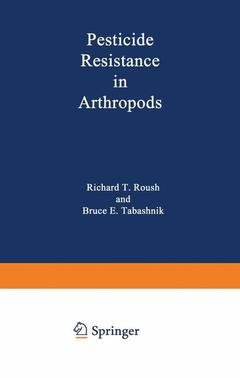Pesticide Resistance in Arthropods, 1990
Langue : Anglais
Coordonnateurs : Roush Richard, Tabashnik Bruce E.

Bruce E. Tabashnik and Richard T. Roush Pesticide resistance is an increasingly urgent worldwide problem. Resistance to one or more pesticides has been documented in more than 440 species of insects and mites. Resistance in vectors of human dise8se, particularly malaria-transmit ting mosquitoes, is a serious threat to public health in many nations. Agricultural productivity is jeopardized because of widespread resistance in crop and livestock pests. Serious resistance problems are also evident in pests of the urban environ ment, most notably cockroaches. Better understanding of pesticide resistance is needed to devise techniques for managing resistance (Le. , slowing, preventing, or reversing development of resistance in pests and promoting it in beneficial natural enemies). At the same time, resistance is a dramatic example of evolution. Knowledge of resistance can thus provide fundamental insights into evolution, genetics, physiology, and ecology. Resistance management can help to reduce the harmful effects of pesticides by decreasing rates of pesticide use and prolonging the efficacy of environmentally safe pesticides. In response to resistance problems, the concentration or frequency of pesticide applications is often increased. Effective resistance management would reduce this type of increased pesticide use. Improved monitoring of resis tance would also decrease the number of ineffective pesticide applications that are made when a resistance problem exists but has not been diagnosed. Resistance often leads to replacement of one pesticide with another that is more expensive and less compatible with alternative controls.
1. Introduction.- 2. Resistance Detection and Documentation: The Relative Roles of Pesticidal and Biochemical Assays.- Types and choice of detection methods.- Initial detection of resistance.- Choice of sample size and strategy.- Assessing factors relevant to resistance management.- Future advances in biochemical assays.- Conclusions.- 3. Investigating Mechanisms of Insecticide Resistance: Methods, Strategies, and Pitfalls.- General considerations for resistance studies.- Methods for identifying resistance mechanisms.- Conclusions.- 4. Molecular Mechanisms of Insecticide Resistance.- Resistance conferred by enhanced detoxication.- Resistance conferred by reduced neuronal sensitivity.- Conclusions.- 5 The Role of Population Genetics in Resistance Research and Management.- Genetic basis of resistance.- Influences on the rates of evolution of resistance.- Genetic perspective on practical resistance management.- Summary and conclusions.- 6 Modeling and Evaluation of Resistance Management Tactics.- Classification of resistance models.- Resistance to one insecticide.- Resistance to two or more insecticides.- Resistance in natural enemy-pest systems.- Conclusions and future directions.- 7 The Effect of Agrochemicals on Vector Populations.- Toxicity of agrochemicals to vectors.- Cases of vector resistance due to agrochemical applications.- Evidence for implication of agrochemicals in vector resistance.- Discussion.- 8 Pesticide Resistance in Arthropod Natural Enemies: Variability and Selection Responses.- Recent reviews.- Naturally occurring pesticide resistances.- Artificial selection of arthropod natural enemies.- Potential new sources of variability.- Conclusions.- 9 Management of Pyrethroid-resistant Tobacco Budworms on Cotton in the United States.- Use of pyrethroids and the occurrence of resistance.- Development of resistance monitoring technique.- Development of resistance management strategy.- Resistance monitoring and success of the management strategy.- Nature of resistance: Extent, biochemistry, and genetics.- Biological costs of resistance to the tobacco budworm.- Field test of insecticide efficacy in relation to the resistance management strategy.- The role of formamidines in pyrethroid resistance management.- Future research needs.- Conclusions.- 10. Resistance Management in Multiple-pest Apple Orchard Ecosystems in Eastern North America.- Resistance to acaricides.- Insecticide resistance in the spotted tentiform leafminer.- Conclusions.- 11. Developing a Philosophy and Program of Pesticide Resistance Management.- Goals, tools, implementation, and constraints to pesticide resistance management (PRM).- A philosophy of resistance management.- Temporal/spatial scales and components of PRM.- The economic/policy environment and constraints to PRM.- Case histories of PRM.- Synthesis of principles.
Date de parution : 06-2012
Ouvrage de 352 p.
17.8x25.4 cm
Disponible chez l'éditeur (délai d'approvisionnement : 15 jours).
Prix indicatif 105,49 €
Ajouter au panierThèmes de Pesticide Resistance in Arthropods :
Mots-clés :
agriculture; arthropods; development; ecology; evolution; genetics; insects; pesticides; physiology
© 2024 LAVOISIER S.A.S.


